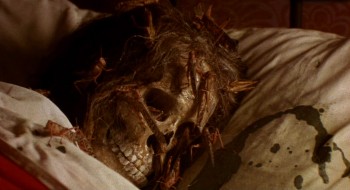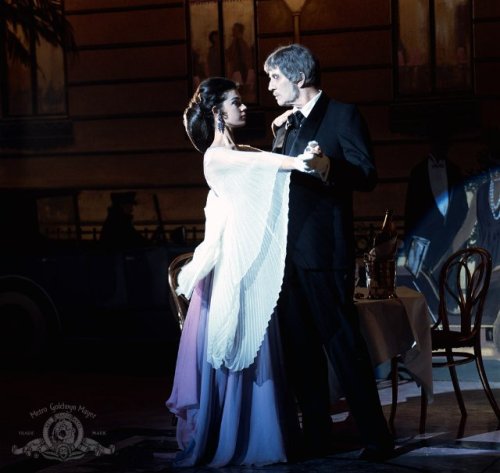Modern horror fans might think the opening scene to The Abominable Dr. Phibes is too long
and rather pointless. The long,
static shot of Phibes (Vincent Price), in a black cape and playing a pipe organ
while arising from a subterranean lair, give the appearance that director
Robert Fuest walked away from the camera, allowing Price to indulge in his
campy side.
And Price does ham it up. His hands wave about without even attempting to match the
soundtrack (though this might not be Price’s fault). But the scene works on two levels. It not only sets up the campy tone of the film, but also is
a brilliant merging of a classic Gothic character into a more modern
setting. Without this scene, the
film would fall flat, and Price’s wonderful campy performance would appear out
of place, rather than just out of time.
As Phibes and his organ arise into a brilliant white, Art Deco themed
ballroom (it’s no surprise if his appearance brings images of The Phantom of
the Opera to mind), the character and the setting meld in a manner a less
elaborate scene would lack. This
opening, and several other bits, makes the film a must see for horror fans.
A Gothic character and Art Deco isn't as easy to combine as chocolate and peanut butter. Just saying.
As expected, the plot is paper-thin. Scotland Yard Detective Trout (Peter
Jeffery) links a series of murders, based on the plagues visited upon Egypt by
Moses, to a medical team that failed to save the life of Victoria Phibes (an
un-credited Caroline Munro) several years earlier. Trout suspects Phibes, despite his reported death in a car
crash as he raced to be at his wife’s side. Working with the lead surgeon, Dr. Vesalius (Joseph Cotton)
to protect the other team members, the pair are always one step behind the
diabolical genius.
Yes, it sounds like little more than an earlier, slower
paced version of the more recent entries in the Saw franchise. While the deaths are imaginative enough
to make Jigsaw applaud in appreciation, Phibes is more interested in revenge
than imparting a moral message.
Fitting into a role of the wronged, disfigured genius seen in countless
films from the start of cinema, Phibes becomes a forgotten fixture in cinema
history, his intentions driven by the simplest desire. His madness is not to teach, nor the
simple blanket of insanity that infused horror films since Psycho. He is the desire to avenge oneself upon
those that wronged him.
But the script, as with the more modern setting, isn’t as
simple minded. During the film’s
climax, Dr. Vesalius earnestly pleads that he and his team did everything
possible to save Victoria. And
while Vesalius’ cries fall upon deaf ears, it does cause the audience to wonder
if her death was unavoidable, rather than caused by malpractice.
Wow, that jury was really harsh!
In addition to their smart decision to leave Phibes’ motives
questionable, screenwriters James Whiton and William Goldstein (and an
uncredited Fuest) inject some wonderful, nasty humor into the script. The
build-ups to, and executions of, the murders are ghoulish fun, as are some of
the end results (just try not to chuckle as the Plauge of the Beasts victim is
removed from the crime scene). And
naming Dr. Vesalius after Andreas Vesalius, the Belgium physician considered
the father of modern anatomical studies (quite likely, given Vesalius’ task at
the climax of the film) shows the writers did their homework, even if the
audience didn’t get the joke.
The cast is wonderful.
While Price overshadows them all, chewing the scenery at every chance,
the others are the perfect foil to Phibes. Their subdued performance set them up as the perfect
straight men and reinforces the idea that Phibes is a character out of place
with the time period. Only
Terry-Thomas gets to ham it up, but only to sell his lecherous glee over a
rather tame stag film.
Virginia North, playing Phibes’ mute assistant Vulnavia,
deserves special mention. The script
never gives any hint why she is aiding Phibes, casting her as a surrogate for
the audience, as we become so captivated by the insane doctor that we become as
willing participant as she is.
Adding to the character’s allure is North’s physical performance. She moves with the grace of a ballerina,
as captivating as Price with a simple movement of a wrist or a graceful spin. IMDb lists this as her final film
credit, which is a shame, as her performance hints at talents untapped in
previous roles.
And she's a terrific dance partner.
The sets, designed by Bernard Reeves, are stunning. And the design of Phibes’ more
futuristic technology is terrific, as the machines still invoke a 1920s
sensibility. It’s a delicate
balancing act, but the film scores once again, making this more of a timeless
fantasy than one set in a particular era.
I’m trying not to spoil much more, as horror fans should
seek out The Abominable Dr. Phibes.
Modern viewers might have trouble with the pace, but I suspect the rich
performances, dark humor and death scenes that don’t need CGI or buckets of
blood to be unnerving will win most horror fans over.
Yea, just try not to squirm when you realize this is a pre-CGI bat.









